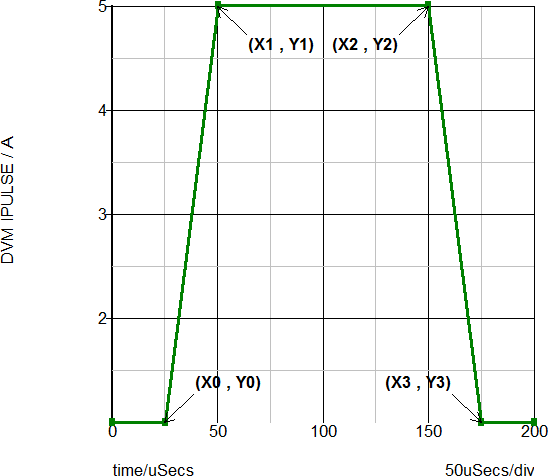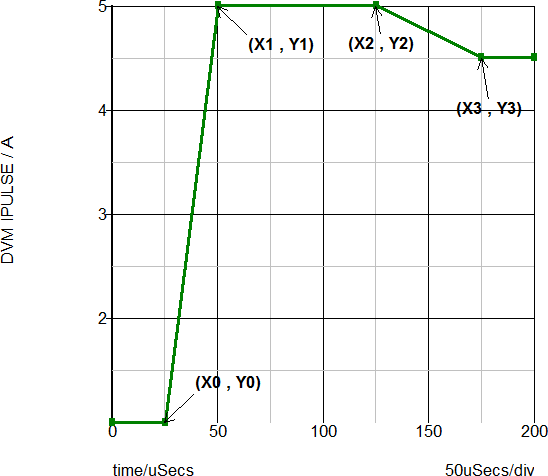DVM - Design Verification Module
|
The Pulse Load - Single Current Pulse subcircuit models a single pulse in parallel with a resistive load. At time=0, the load starts at the resistive load. The load pulse is determined by the pulse parameters. You can configure any managed DVM load to a Ramp Pure Load with a Pulse() function call in the Load column of your testplan.
This load is used in the following test objectives:
Other similar loads include the following:
In this Topic Hide
The table below explains the parameters used in the Pulse Load - Single Current Pulse subcircuit.
| Parameter Name | Default | Data Type | Range | Units | Parameter Description |
FALL_TIME |
50u | Real | min: 0 | s | The pulse fall time in seconds |
FINAL_CURRENT |
750m | Real | min: 0 | A | The final current for the PWL current source portion of the load. The Pulse Load - Single Current Pulse continues at this current for all simulation times greater than TIME_DELAY + RISE_TIME. This can be a numeric value or a symbolic value, such as a percentage of full load. |
LOAD_NAME |
LOAD | String | n/a | n/a | Name of the DVM load. This name cannot contain spaces. |
LOAD_RESISTANCE |
2.00667 | Real | min: 0 | Ω | The resistance value which models the starting current of the load |
PULSE_CURRENT |
250m | Real | min: 0 | A | The pulsed current in amps. The pulse current can be a numeric value or a symbolic value, such as a percentage of full load. |
PULSE_WIDTH |
200u | Real | min: 0 | s | The pulse width in seconds.
Note: DVM considers the pulse width to be the duration of the pulse at the PULSE_CURRENT. |
RISE_TIME |
100u | Real | min: 0 | s | The pulse rise time in seconds |
START_CURRENT |
0 | Real | min: 0 | A | The starting current for the PWL current source portion of the load. This is typically set to 0 since the minimum load current is modeled with the LOAD_RESISTANCE parameter. |
TIME_DELAY |
10u | Real | min: 0 | s | The time delay before the pulse initiates |
To set any managed DVM load to a Pulse Load - Single Current Pulse subcircuit, place a Pulse() testplan entry in the Load column.
The Pulse() testplan entry has the following syntax with the arguments explained in the table below.
Pulse(REF, ISTART,
IPULSE, IFINAL)
Pulse(REF, ISTART,
IPULSE, IFINAL, OPTIONAL_PARAMETER_STRING)
where:
| Argument | Range | Description |
REF |
n/a |
The actual reference designator of the DVM load or the more generic syntax of OUTPUT:n where n is an integer indicating a position in the list of managed DVM loads. |
ISTART |
min: 0 |
The starting current for the load. In the Pulse load, the starting current is modeled with a resistor. This can be a numeric value or a symbolic value, such as a percentage of full load. |
IFINAL |
min: 0 |
The final current for the load. This can be a numeric value or a symbolic value, such as a percentage of full load. |
OPTIONAL_PARAMETER_STRING |
n/a |
Parameter string with a combination of one or more timing parameters:
|
* If more than one parameter is specified, join the parameter key-value pairs with a space, as shown in the example below. The order of the parameter names does not matter.
DVM calculates the LOAD_RESISTANCE parameter from the $I_{START}$ argument and subtracts the equivalent starting current from the PWL portion of the load. The calculation for the LOAD_RESISTANCE parameter is based on the following:
Note: If the specified starting current is 0 and the load is configured by DVM using either a Pulse() function or the PulseLoad() test objective, DVM replaces the Pulse Load - Single Current Pulse subcircuit with a Pulse Load - Single Pure Current Pulse subcircuit. The Pulse Load - Single Current Pulse does not use a parallel resistance to model the starting current.
DVM sets the timing of the Pulse Load - Single Current Pulse in the PulseLoad() test objective. You can change the timing with a Pulse() function call by providing the timing parameters as an optional parameter string, which is the fifth argument to the Pulse() function call.
This example shows a symmetric pulse with equal rise and fall times. The final current is the same as the starting current.
Note: In this example, the Load column is the first column in the testplan and, therefore, begins with the special three character sequence: *?@.
| *?@ Load | ||||
|---|---|---|---|---|
| Pulse(OUTPUT:1, 1, 5, 1, TIME_DELAY=25u RISE_TIME=25u PULSE_WIDTH=100u FALL_TIME=25u) | ||||
The results of this testplan entry are shown below:

| Annotation | Value |
| X0 | TIME_DELAY |
| X1 | TIME_DELAY + RISE_TIME |
| X2 | TIME_DELAY + RISE_TIME + PULSE_WIDTH |
| X3 | TIME_DELAY + RISE_TIME + PULSE_WIDTH + FALL_TIME |
| Y0 | ISTART (see note below) |
| Y1 | IPULSE (see note below) |
| Y2 | IPULSE (see note below) |
| Y3 | IFINAL (see note below) |
Note: The actual load current depends on the LOAD_RESISTANCE parameter and the actual time-varying load voltage. The $I_{START}$ current is modeled by a resistor defined by the LOAD_RESISTANCE parameter in the pulse load subcircuit. The PWL current source has points defined by the ramp-load START_CURRENT, PULSE_CURRENT, and FINAL_CURRENT parameter values.
The following example sets the first DVM managed load to a Pulse Load - Single Current Pulse with a starting current of 1A, a pulse current of 5A, and a final current of 4.5A.
Note: The rise and fall times are not the same and the pulse does not have to return to the starting current value.
| *?@ Load | ||||
|---|---|---|---|---|
| Pulse(OUTPUT:1, 1, 5, 4.5, TIME_DELAY=25u RISE_TIME=25u PULSE_WIDTH=75u FALL_TIME=50u) | ||||
The results of this testplan entry are shown below:

| Annotation | Value |
| X0 | TIME_DELAY |
| X1 | TIME_DELAY + RISE_TIME |
| X2 | TIME_DELAY + RISE_TIME + PULSE_WIDTH |
| X3 | TIME_DELAY + RISE_TIME + PULSE_WIDTH + FALL_TIME |
| Y0 | ISTART (see note below) |
| Y1 | IPULSE (see note below) |
| Y2 | IPULSE (see note below) |
| Y3 | IFINAL (see note below) |
Note: The actual load current depends on the LOAD_RESISTANCE parameter and the actual time-varying load voltage. The $I_{START}$ current is modeled by a resistor with resistance LOAD_RESISTANCE, while the PWL current source has points defined by the START_CURRENT and FINAL_CURRENT parameter values.
© 2015 simplistechnologies.com | All Rights Reserved